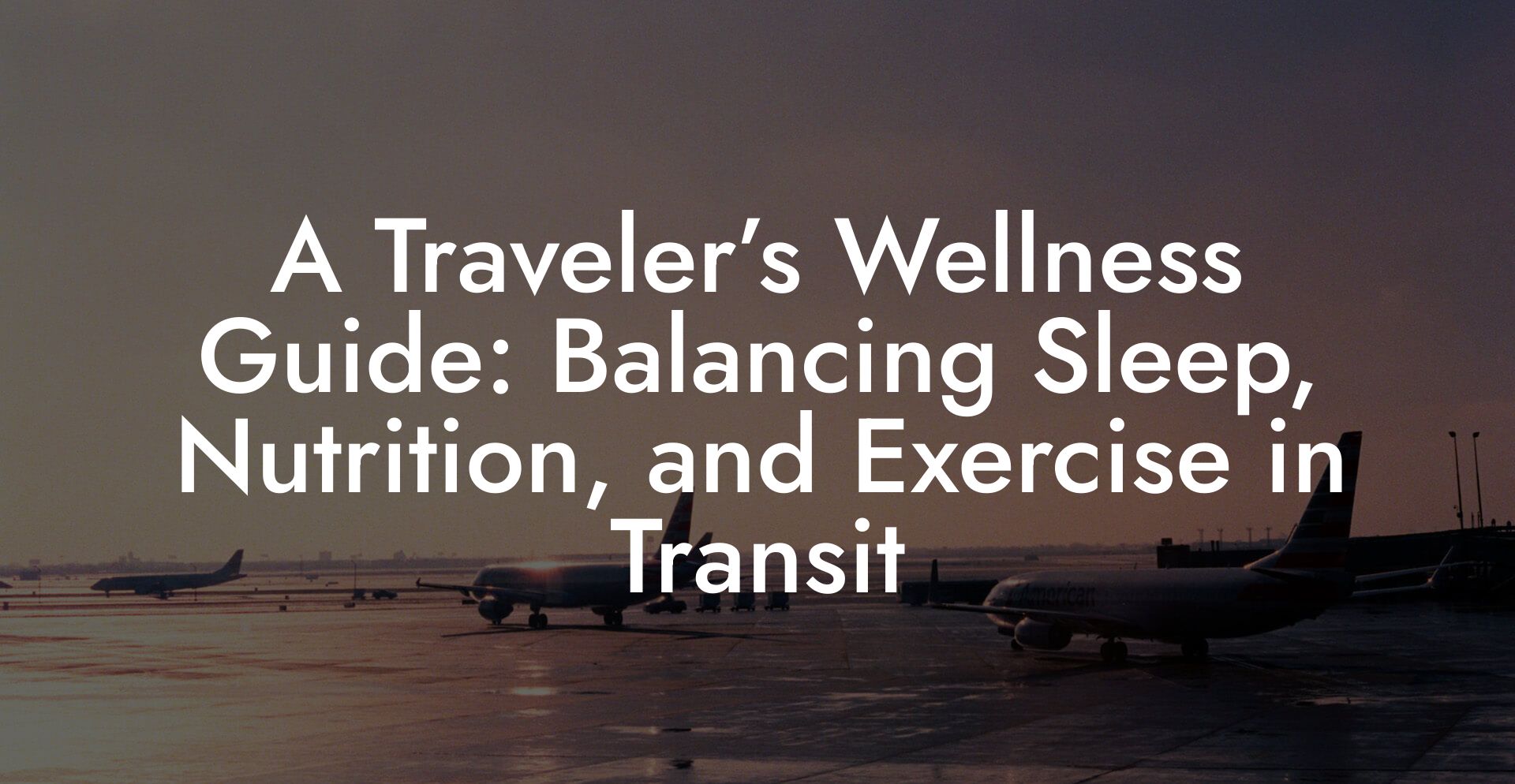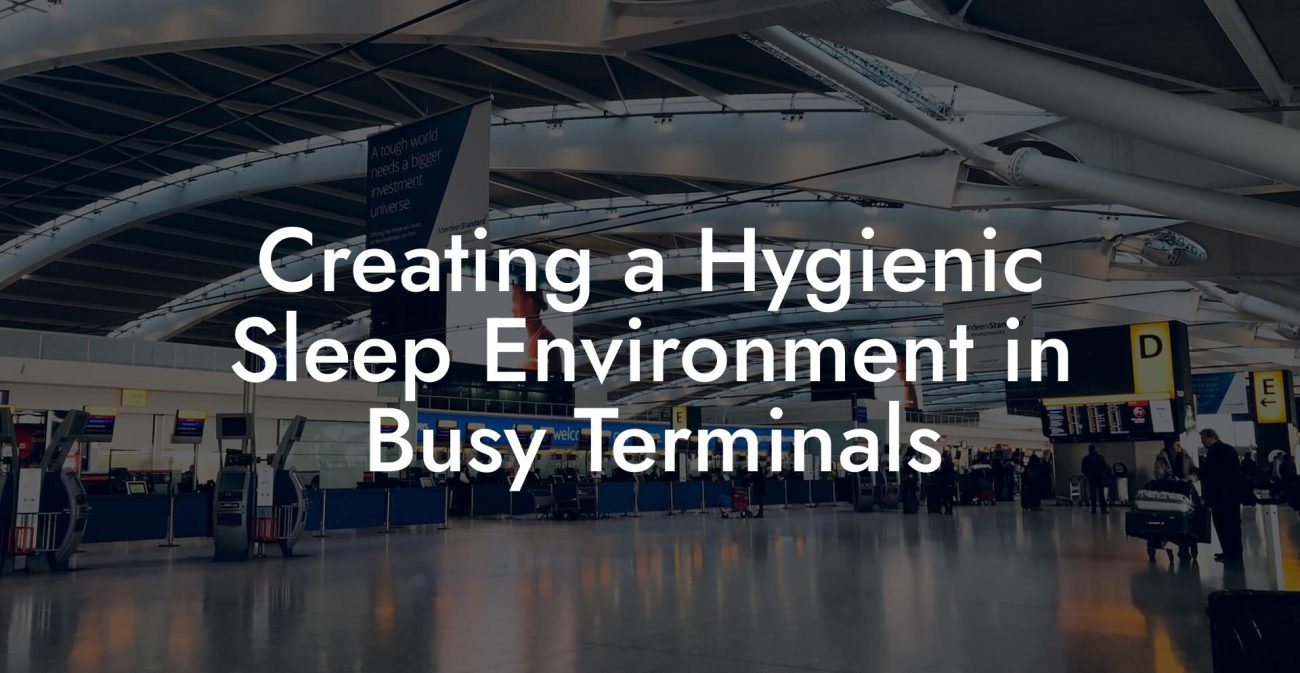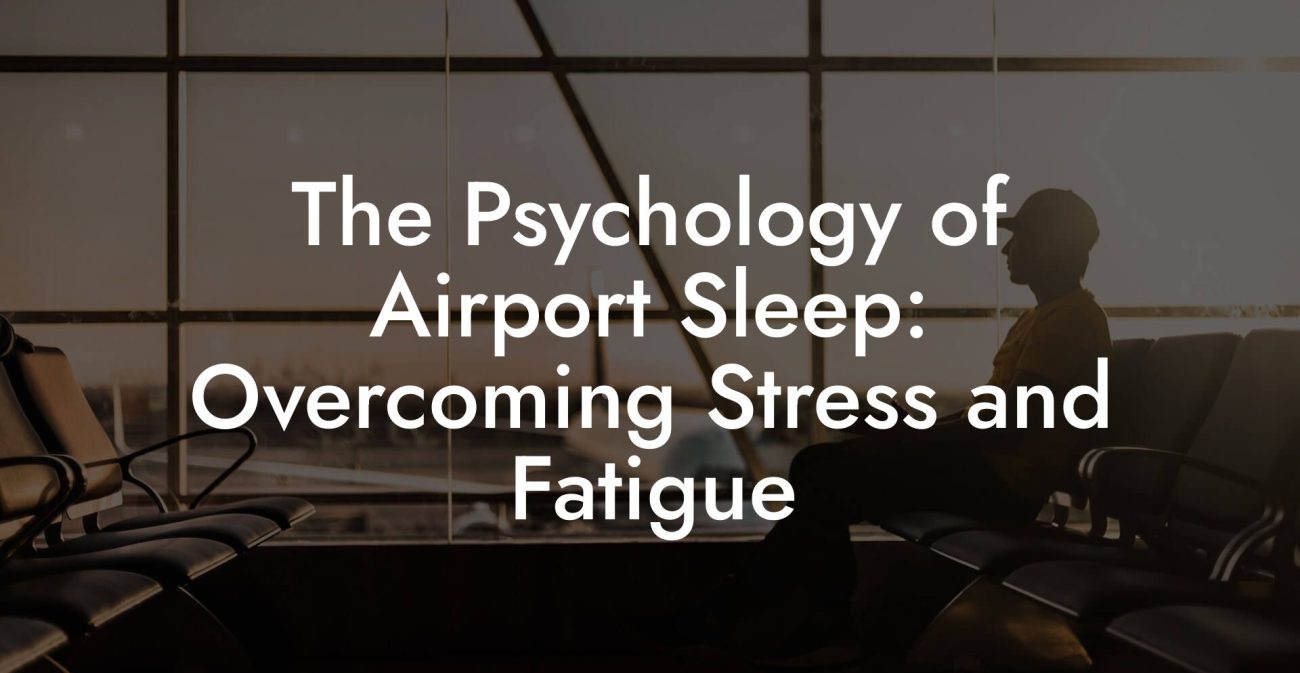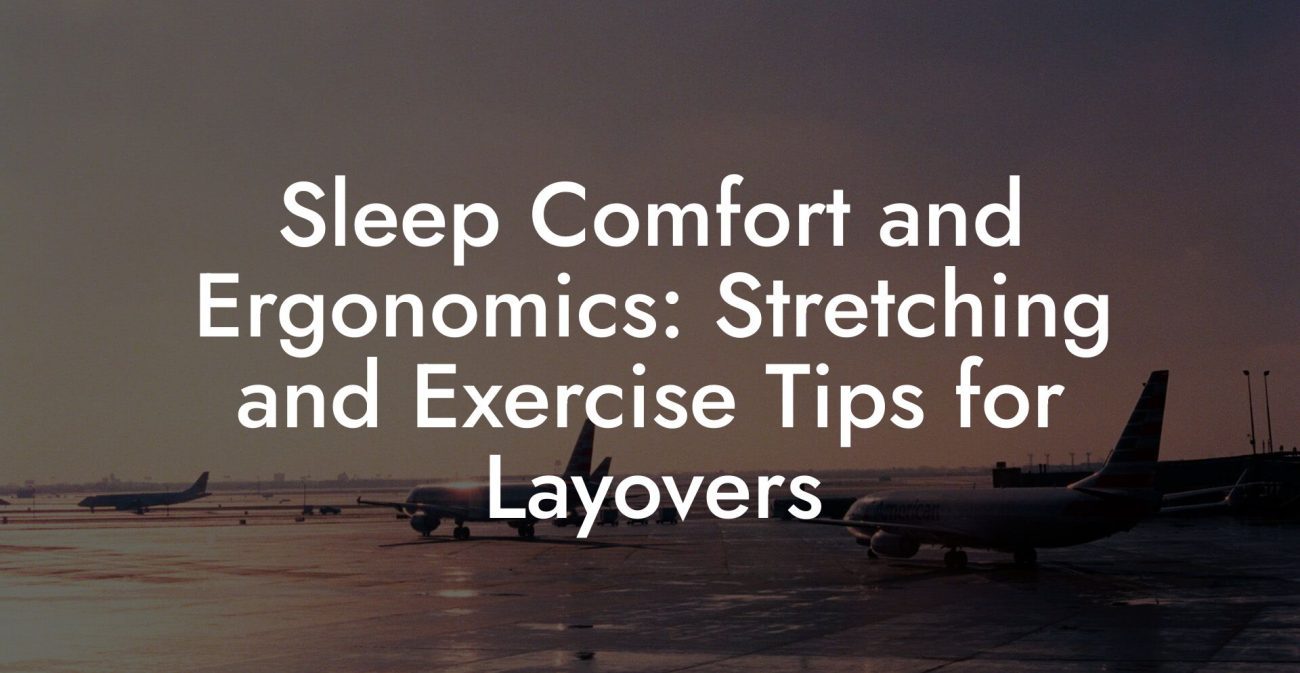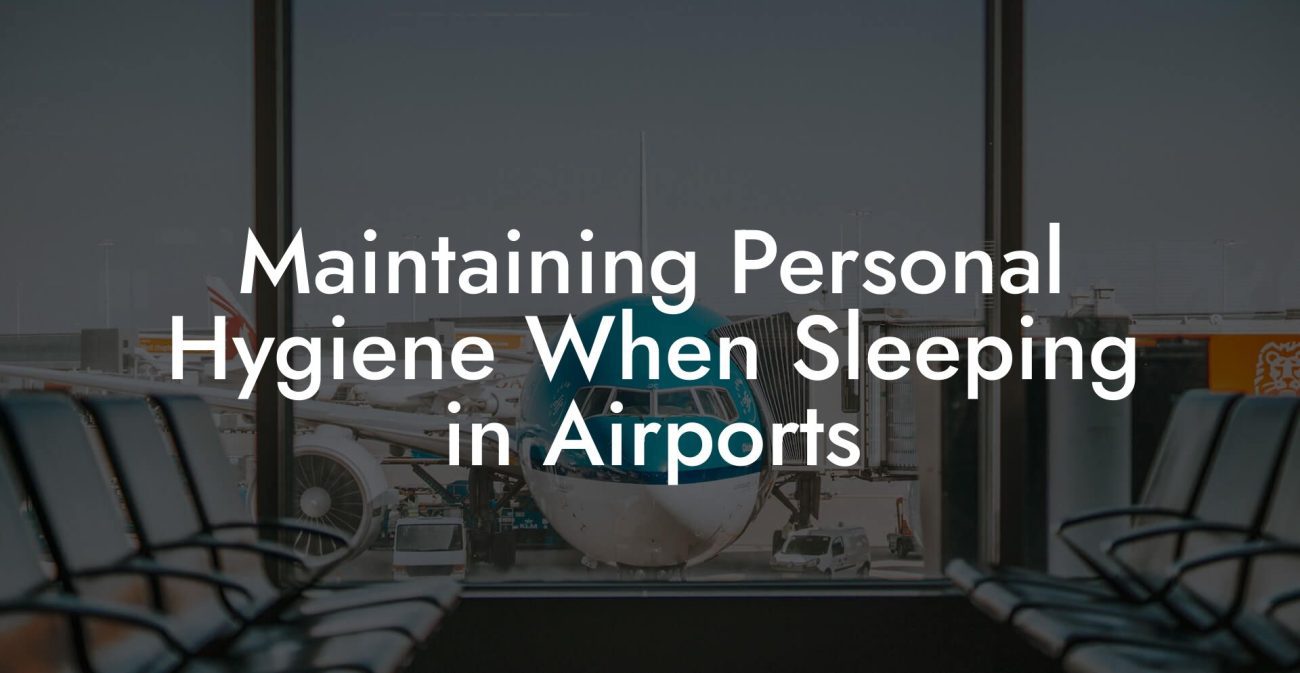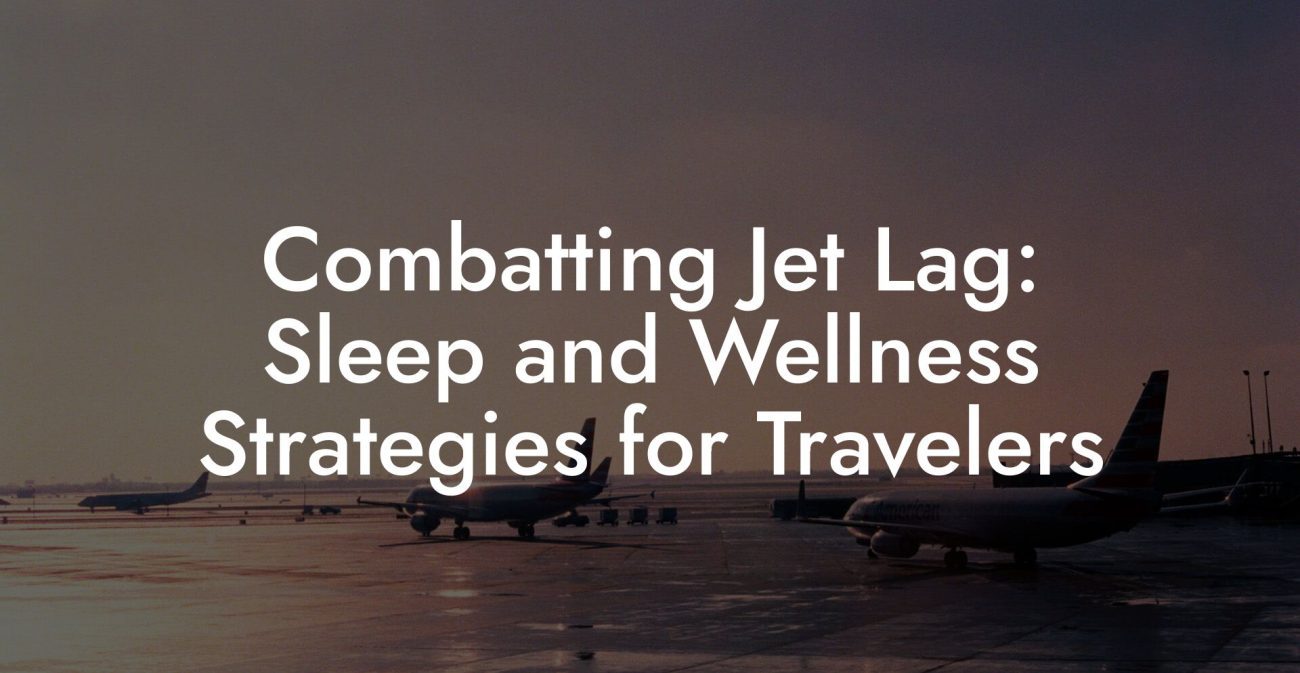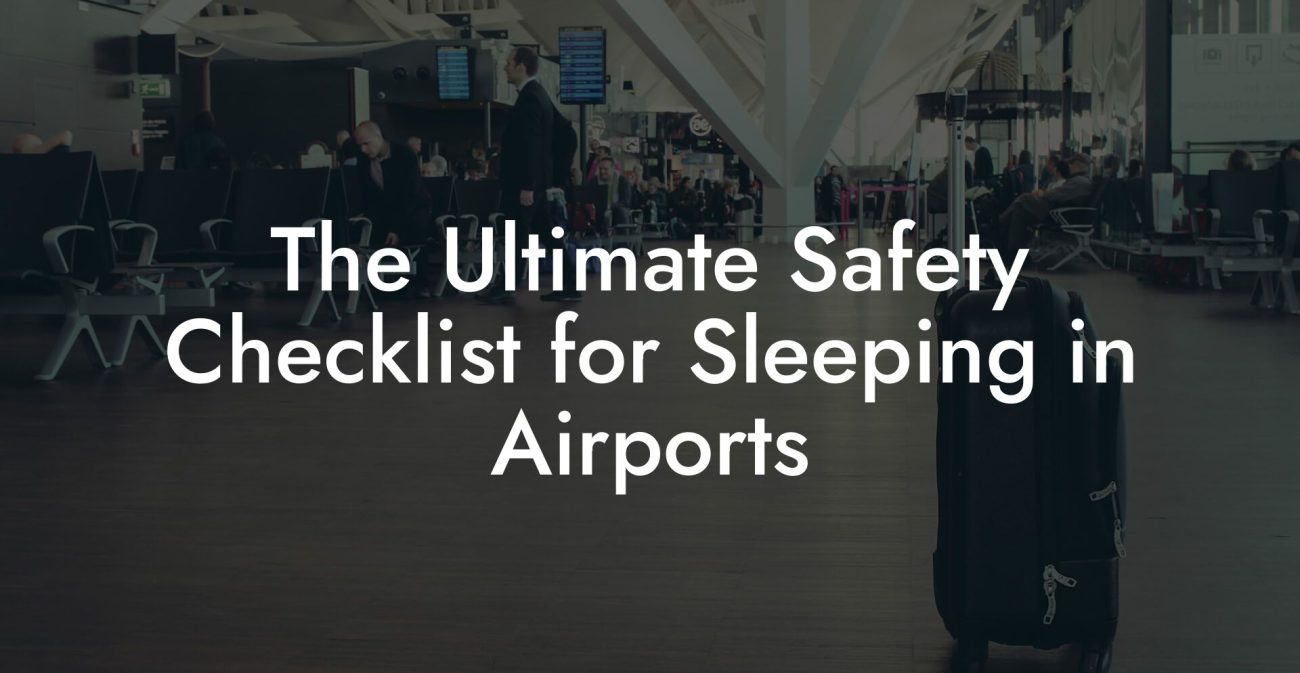Ever found yourself wrestling with the twin demons of jet lag and exhaustion in a bustling airport, wondering if your body could ever function on caffeine alone? In the midst of travel chaos, where your layover feels longer than a season of your favorite show and your diet consists mainly of airport lattes and mystery deli sandwiches, there’s a rebellious call for wellness. Welcome to “A Traveler’s Wellness Guide: Balancing Sleep, Nutrition, and Exercise in Transit” – your no-nonsense, laugh-out-loud, and downright practical blueprint for mastering the art of in-transit wellness. Whether you’re a digital nomad, a perpetual wanderer, or a vacationing millennial digging for that elusive good night’s sleep in an airport lounge or a trendy sleeping pod, this guide is designed with you in mind.
Quick Links to Useful Sections
- The In-Transit Revolution: Why Wellness Doesn’t Take a Vacation
- Sleeping in Transit: From Terminal Naps to State-of-the-Art Sleep Pods
- Nourishing on the Go: Fueling Your Journey with Smart Nutrition
- Sweat, Stretch, and Smile: Exercising When You’re On the Move
- The Mind-Body Connection: Managing Stress and Embracing Mindfulness
- Tech Tools for the Modern Nomad: Gadgets and Apps That Elevate Your Journey
- Building Your Personalized Traveler Wellness Plan
- Step 1: Assessing Your Travel Lifestyle
- Step 2: Defining Your Wellness Priorities
- Step 3: Integrating Practical Actions into Your Itinerary
- Step 4: Gathering Your Tech and Tools
- Step 5: Evaluating and Evolving Your Routine
- Resources and Community Support: Your Next Steps
- Frequently Asked Questions About In-Transit Wellness
- Embracing Your Journey to Sustainable Traveler Wellness
The In-Transit Revolution: Why Wellness Doesn’t Take a Vacation
Let’s face it: travel can be both exhilarating and exhaustingly unpredictable. One minute you’re marvelling at new cityscapes, and the next, you’re buried under the weight of your carry-on in an overcrowded terminal. But here’s the twist – your journey doesn’t have to be a series of missed meals and sleepless nights. Instead, by weaving smart habits into your travel routine, you can transform every layover, connecting flight, and airport pit stop into an opportunity to refuel your body, recharge your mental batteries, and maybe even break a sweat.
In today’s fast-paced world, where being on the move is synonymous with living life to the fullest, travelers from Gen Z to millennials are rewriting the wellness rulebook. This guide dives deep into the realms of sleep hacks, nutritional brilliance, and exercise tips that work whether you’re crammed in a cozy sleeping pod or exploring a new city on foot.
We’re here to bust myths like “airports are sleep no-go zones” and “eating healthy on the fly is impossible.” From futuristic sleeping pods to workout routines that require nothing more than body weight and determination, discover how to harness your in-transit time, balance your bodily needs, and even have a little fun along the way. So, toss aside that pre-flight anxiety and get ready to level up your travel game.
Sleeping in Transit: From Terminal Naps to State-of-the-Art Sleep Pods
When your journey begins at 3 AM and your only destination seems to be the dreaded “layover lounge,” finding quality sleep may feel like searching for Wi-Fi in the wilderness. Yet, modern travel has birthed innovative solutions to combat the notorious airport snooze. Let’s explore some of these sleep solutions.
Airport Sleeping Pods and Nap Suites:
Imagine stepping into a private, futuristic capsule designed exclusively for catching some Z’s. Today’s airports are sprouting sleek sleeping pods that not only provide a sanctuary of quiet amidst chaos but also boast ergonomic designs, ambient lighting, and even noise-cancelling features. These pods cater to the needs of the sleep-deprived traveler by offering a mini retreat that lulls you into a restful slumber.
The Art of Airport Napping:
Not every airport has a dedicated sleep pod, but fear not! Mastering the art of the airport nap is an invaluable skill. Find a secluded corner, invest in a quality travel pillow, and wrap yourself in a cozy, compact blanket (those weighted blankets on your travel bucket list might just come in handy today). A few expert tips: set an alarm to avoid missing your flight, don a sleep mask to block out the harsh overhead lights, and, if possible, wear noise-cancelling headphones with some chill tunes or white noise.
Timing is Everything:
For many, aligning your sleep with your destination’s time zone is a masterstroke. This may mean bunking down during a layover, even if it defies your habitual bedtime. Embrace the chaos, and soon you may find that you’re not just sleeping—you’re powering up your body’s reset button.
Beyond the Pod: Creative Sleep Hacks:
When pods and plush lounges aren’t available, think small adjustments. Consider reclining chairs, quiet corners of lesser-known terminals, or even renting a day-use hotel room near the airport. Sometimes, what you need is a little creativity and the willingness to call your travel routine into question.
These smart sleep strategies not only help you recover from long flights but also set a positive tone for the rest of your journey. After all, effective sleep is the secret ingredient that let’s you hit the ground (or terminal) running.
Nourishing on the Go: Fueling Your Journey with Smart Nutrition
Let’s break a taboo: you don’t need to rely on greasy fast-food chains lurking in every airport terminal to eat healthily on the go. In fact, making informed nutritional choices while traveling is not only possible—it’s downright empowering.
Grab-and-Go Goodness:
Many modern airports are now home to innovative food vendors offering everything from avocado toast to vegan bowls. Look for kiosks that prioritize fresh ingredients and balanced meals. Think of your airport meals as an opportunity to experiment with flavors that you wouldn’t normally try—bonus points if you snap an Instagram-worthy plate.
Portable Super Snacks:
Keep your carry-on stocked with travel-friendly snacks that don’t require a microwave or a fancy restaurant reservation. Nuts, protein bars, fresh fruit, and homemade smoothie packs are a few ideas. These snacks are your secret weapons in warding off the mid-flight hunger pangs and ensuring you maintain a steady energy level.
Hydration is Key:
Ever noticed how the in-flight air can leave your throat as dry as a desert? Staying hydrated is essential, so carry a reusable water bottle and refill it at water stations (or splurge on a fruit-infused water from your favorite airport café). Hydration not only boosts energy but also contributes significantly to your overall well-being.
Mindful Indulgence:
Travel is also about experiencing new cultures, which often means diverse cuisines. Learn to curate your indulgence—savor local specialties in moderation while balancing them with nutrient-rich options. Consider this your opportunity to blend healthy eating with culinary adventure.
Plan Ahead:
A little foresight can go a long way. Before embarking on your journey, map out eateries within the airport or your destination that cater to wholesome meals. Use apps and review sites to scout spots that align with your nutritional values. This pre-planning saves you from the dreaded “hangry” moments.
Integrating smart nutrition into your travel routine ensures that despite all the hustle and bustle, your body isn’t left behind in the pursuit of good experiences. Eating well is not merely about fueling up; it’s about powering your adventures with clarity and vigour.
Sweat, Stretch, and Smile: Exercising When You’re On the Move
So you’re stuck in a terminal with minutes to spare before boarding, and the only fitness option seems to be dashing between gates. But what if you could channel those frantic steps into a purposeful in-transit workout? Let’s explore creative, effective ways to squeeze exercise into your travel day.
Airport Workouts:
Yes, they exist—and you can do them in style. Many airports are beginning to offer dedicated fitness zones or yoga rooms. If your terminal doesn’t have one, find an open area on the concourse and let your body move. Simple body-weight exercises like squats, lunges, and push-ups can be performed without drawing any undue attention, and they’ll keep your muscles humming along nicely.
Hotel Room HIIT:
When you finally check into your hotel, don’t let that mini room fool you. High-intensity interval training (HIIT) routines, which require very little space, can be your secret weapon to re-energize after a long day of travel. There are countless apps and online videos specifically geared toward workouts in confined spaces.
Strolling Is the New Running:
If hitting the gym isn’t feasible, consider long walks as part of your travel itinerary. Instead of rushing through terminals or tourist attractions, take a leisurely stroll and immerse yourself in your surroundings. Walking not only serves as low-impact exercise but also offers time to decompress and observe the quirky details of new places.
Stretch It Out:
Sitting cramped on a plane or in a waiting area can tighten up muscles faster than you can say “seatbelt sign.” Incorporate simple stretching exercises into your routine—roll your shoulders, extend your arms, and give your legs a good stretch. Even a few minutes of mindful stretching can combat stiffness and refresh your body.
Tech-Enabled Fitness:
Fitness trackers and mobile apps can revolutionize your in-transit workout, offering structured routines and even reminders to move throughout the day. If you’re a tech-savvy traveler, these digital allies can monitor your steps, heart rate, and overall activity, ensuring that you’re not just traveling—you’re thriving.
Exercise on the go is all about embracing the concept that every step and every stretch counts. It’s about transforming idle moments into opportunities for movement, ensuring that your body remains agile, resilient, and ready for the next adventure.
The Mind-Body Connection: Managing Stress and Embracing Mindfulness
Traveling inevitably brings a mix of excitement and stress. Whether it’s navigating delayed flights, deciphering public transit systems in a foreign language, or just managing the eccentricities of travel gear, stress is an unavoidable travel companion. Fortunately, channeling mindfulness and managing stress is completely within your grasp.
Mindfulness on the Move:
Incorporate moments of mindfulness throughout your journey. Use your layover to find a quiet spot, close your eyes, and practice deep breathing or meditation. These mini-sessions can lower your cortisol levels and reset your mental state, making turbulence—both literal and figurative—a bit more bearable.
Travel Journaling:
Channel your inner creative by jotting down observations, reflections, or even doodling on a notepad. This mindful act not only helps process the day’s experiences, but it also serves as a reminder that you are actively engaged in shaping your narrative, even amidst the chaos of airports.
Digital Detox:
Sure, smartphones make travel easier, but they also keep you tethered to news cycles, work alerts, and social media pressure. Set aside dedicated “unplugged” moments to fully absorb the present. This is your time to disconnect from the digital world and reconnect with your inner self.
Stress-Busting Movement:
Combine movement with mindfulness by engaging in yoga or tai chi—activities that harmonize the mind and body. Even if you’re in a cramped waiting area, a few mindful stretches can reduce tension and help maintain focus.
Embracing mindfulness on the go isn’t about turning every moment into a meditation retreat. It’s about recognizing that a few deep breaths or a quiet moment in the chaos can be the difference between frazzled frustration and a centered, poised traveler.
Tech Tools for the Modern Nomad: Gadgets and Apps That Elevate Your Journey
In today’s digital era, a traveler’s toolkit extends well beyond suitcases and boarding passes. For the wellness-savvy, your smartphone is a portal to a plethora of apps, gadgets, and services that make balancing sleep, nutrition, and exercise easier than ever.
Sleep-Tracking Apps and Devices:
Ever wonder if those airport sleeping pods are the real deal? Use apps with sleep tracking features to monitor your sleep quality in unconventional settings. Devices like smartwatches or portable sleep trackers can provide insights into your sleep patterns, helping you adjust your routines for maximum recovery.
Nutrition and Meal Planner Apps:
When you’re hopping from one destination to another, keeping your diet balanced might seem like a daunting challenge. Enter nutrition apps that help you log meals, track calories, and even suggest healthy food options at airports or in unfamiliar cities. With just a few taps, you can ensure that every bite is a step toward optimum wellness.
Fitness Apps and Portable Workouts:
There are apps designed specifically for travelers that offer quick, high-impact workouts needing minimal space and equipment. Whether you’re in a cramped hotel room or a spacious park, you can access routines that keep your blood pumping and muscles engaged.
Language and Navigation Tools:
Let’s not underestimate the value of technology that simplifies your journey. Translation apps, digital maps, and ride-sharing services ensure that the stress of navigating new environments is kept to a minimum, leaving you more time to focus on wellness.
Community and Social Platforms:
Connect with like-minded travelers through wellness forums, social media groups, or specialized apps. Sharing tips, workout routines, and healthy recipes not only builds a support network but also transforms your travel experiences into collaborative adventures in well-being.
In an age where technology is your co-pilot, harness these digital tools to create a travel routine that not only gets you from point A to point B but does so while keeping your mind, body, and spirit in top form.
Building Your Personalized Traveler Wellness Plan
With a wealth of strategies for sleep, nutrition, exercise, and stress management at your fingertips, it’s time to craft your own tailor-made travel wellness blueprint. Here’s a roadmap to help you create a plan that adapts to your lifestyle, travel itinerary, and unique wellness needs:
Step 1: Assessing Your Travel Lifestyle
Take inventory of your travel habits. Are you a frequent flyer constantly moving from one city to the next, or do you prefer the occasional escape? Identify common stressors, like long layovers, tight schedules, and unpredictable meal options. Knowing your travel challenges sets the stage for crafting a plan that addresses them head-on.
Step 2: Defining Your Wellness Priorities
Do you crave quality sleep amid airport chaos? Are you looking to maintain a healthy diet despite the inevitable indulgences of travel? Or maybe you want a quick workout routine to energize your layovers? Set clear, achievable wellness goals that resonate with your lifestyle. Whether it’s optimizing your sleep cycles, adopting superior nutrition practices, or integrating short burst exercises, your plan should reflect your personal priorities.
Step 3: Integrating Practical Actions into Your Itinerary
Strategize your travel schedule by allocating time for sleep breaks, meal planning, and physical activity. Reserve a few hours during long layovers to disconnect and recharge—whether that means booking a sleeping pod, exploring a healthy restaurant, or stepping into an airport fitness zone. Visualize each transit period as an opportunity to invest in your wellness.
Step 4: Gathering Your Tech and Tools
Equip yourself with the digital allies mentioned earlier—a sleep tracker, nutrition apps, fitness routines, and even language tools that ease your navigation. These technologies bridge the gap between your travel demands and your wellness goals, ensuring that every moment becomes a pillar in your healthy lifestyle.
Step 5: Evaluating and Evolving Your Routine
Your first travel wellness plan might not be perfect, and that’s okay. Keep a travel diary to note what works and what needs rethinking. Over time, you’ll hone a routine that evolves as your travel lifestyle changes, ensuring you always have a personalized blueprint that adapts to your current needs.
A personalized traveler wellness plan isn’t a one-size-fits-all affair; it’s a dynamic strategy that empowers you to take control of your well-being, no matter where your next flight lands.
Resources and Community Support: Your Next Steps
Embarking on your journey toward balanced travel wellness doesn’t have to be a solo endeavor. There is a thriving community of like-minded explorers, wellness coaches, and digital nomads out there who share your passion for pioneering a healthier way to travel.
Online Wellness Communities:
From dedicated travel wellness forums to social media groups on Instagram and Facebook, countless communities offer support, share success stories, and exchange innovative travel hacks. Engage, ask questions, and swap tips with fellow travelers who understand the challenges and triumphs of maintaining health on the move.
Workshops and Webinars:
Look out for online webinars, live Q&A sessions, and local workshops that focus on travel wellness. Experts in sleep science, nutrition, and fitness often share their insights and answer burning questions, giving you the edge in your next adventure.
Local Resources at Your Destination:
Research wellness centers, organic cafes, and scenic parks at your destination. Not only does this enrich your travel experience, but it also offers practical ways to incorporate healthy habits when you land.
Personal Wellness Coaches:
Consider partnering with a travel-friendly wellness coach who can help you tailor a personal plan. Virtual coaching sessions can introduce creative ideas and accountability, ensuring your travel wellness remains a priority.
These resources, both online and offline, act as your support network—empowering you to constantly upgrade your travel wellness routine while connecting with a vibrant community that’s always ready to cheer you on.
Frequently Asked Questions About In-Transit Wellness
Here are some of the most common questions travelers ask about balancing sleep, nutrition, and exercise on the go, along with practical insights to help you keep thriving while traveling.
1. How can I sleep better in an airport without a designated sleeping area?
Even if your airport lacks a dedicated sleeping pod, you can create your own sleep haven with a quality travel pillow, an eye mask, and noise-cancelling headphones. Choose a quiet corner, recline in your seat, or search for an isolated lounge area. Small adjustments can significantly improve your in-transit sleep.
2. What healthy food options are available in airports?
Many modern airports now offer grab-and-go options featuring fresh salads, fruit bowls, and protein-packed wraps. In addition, you can always pack your own super snacks—nuts, dried fruits, or even homemade smoothie packs—to ensure you have nutritious choices at hand.
3. Are airport sleeping pods worth the splurge?
For many travelers, sleeping pods provide a quiet, secure space with facilities designed for rest, making them a worthwhile investment to beat jet lag. If your budget allows, give them a try and see if the comfort and privacy help recharge your batteries.
4. Can I exercise in cramped spaces like an airplane or a hotel room?
Absolutely. There are body-weight exercises and HIIT routines that require minimal space, making them perfect for hotel rooms or even a short terminal walk. Simple stretches, squats, lunges, or a quick yoga session can keep you active without needing a gym.
5. How do I manage stress while navigating hectic travel schedules?
Incorporate mindfulness practices such as deep breathing, meditation, or short moments of journaling into your schedule. Disconnecting from your digital devices for a few minutes can also help create mental space and reduce travel-induced anxiety.
6. What travel apps can help maintain my wellness routine?
There are a variety of apps available—sleep trackers to monitor your rest, meal planners for nutritious choices, and fitness apps with guided exercises. Additionally, language and navigation apps can ease travel stress, allowing you to focus on self-care.
7. How can I adapt my wellness routine to different time zones?
Adjust your routine gradually before traveling by shifting your sleep and meal times. Once on the go, aim to sync with your new time zone as soon as possible by exposing yourself to natural light and using techniques such as melatonin supplements (after consulting your doc) to regulate your body clock.
Embracing wellness is a journey—one that involves creativity, planning, and the courage to try new approaches even when travel throws you off your routine.
Embracing Your Journey to Sustainable Traveler Wellness
At the intersection of adventure and self-care lies your in-transit wellness journey—a path where every airport terminal becomes a space for rejuvenation, every meal is an opportunity for nourishment, and every step is a stride toward better health. Embracing the balance between sleep, nutrition, and exercise doesn’t mean sacrificing comfort or fun; it means reimagining the very fabric of travel in a way that honors both your wanderlust and your well-being.
Every challenge thrown by delayed flights and unpredictable itineraries can transform into a moment of self-discovery and empowerment. Whether you’re nestled inside a state-of-the-art sleeping pod, crafting your next healthy meal, or sneaking in a quick workout in a cozy hotel room, remember that wellness is not a destination—it’s a journey.
So, next time you’re jetting off to explore a new city or continent, challenge the norm. Embrace that unexpected layover as your time to reset, recharge, and rediscover the joy of balance. The world is vast, and your journey to sustainable traveler wellness is just beginning. With a balanced routine, smart planning, and a little creativity, every flight, every connection, and every moment in transit becomes a stepping stone toward a healthier, happier you.
Let this guide be your trusted companion on the road or runway—a manifesto for turning hustle into health, chaos into calm, and travel stress into a vibrant celebration of life. Your path to empowered in-transit wellness awaits, so pack your bags not just with clothes and gadgets, but with the intention to live fully, healthily, and unapologetically on the move.
Useful Interruption: Dive deeper into the world of airport sleeping guides with our most popular sections. If there is anything you think is missing or anything you would love for us to write about, just give us a shout.
- General Airport Sleeping Guides
- Travel Gear & Equipment Recommendations
- Regional and Airport-Specific Guides
- Airport Sleeping Pods & Reviews
- Health, Safety, and Comfort Tips for Airport Sleepers
Last week, I decided to try the world-famous "airport sleepover" experience. Imagine this: I'm lying on a bench in Terminal C, surrounded by suitcases that have seen more of the world than I ever will, and a PA system that sounds like a karaoke machine on a sugar rush. I pull out my travel pillow—which, by the way, is more like a sad deflated balloon—and declare, "Tonight, I’m the king of this terminal!"
Soon enough, fellow travelers become my unexpected audience. One guy, fresh off a red-eye, whispers, "Hey, do you think if we sleep long enough, we can catch our flight in our dreams?" I reply, "Sure, and maybe I'll even get an upgrade to first-class in my nap!" The airport lights flicker like a disco ball, and every time someone announces a delayed departure, it’s like a punchline to our impromptu stand-up routine.
As I finally drift off, I dream of a world where boarding passes are like VIP tickets to the best sleepover party ever—a party where the only baggage is the laughter you carry with you. Waking up, I realize the airport is still the same, but I now hold the honorary title of "Terminal Comedian," a title I wear with as much pride as my permanently mismatched socks!

